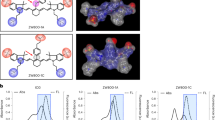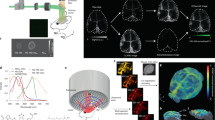Abstract
As Alzheimer's disease pathogenesis is associated with the formation of insoluble aggregates of amyloid β-peptide, approaches allowing the direct, noninvasive visualization of plaque growth in vivo would be beneficial for biomedical research. Here we describe the synthesis and characterization of the near-infrared fluorescence oxazine dye AOI987, which readily penetrates the intact blood-brain barrier and binds to amyloid plaques. Using near-infrared fluorescence imaging, we demonstrated specific interaction of AOI987 with amyloid plaques in APP23 transgenic mice in vivo, as confirmed by postmortem analysis of brain slices. Quantitative analysis revealed increasing fluorescence signal intensity with increasing plaque load of the animals, and significant binding of AOI987 was observed for APP23 transgenic mice aged 9 months and older. Thus, AOI987 is an attractive probe to noninvasively monitor disease progression in animal models of Alzheimer disease and to evaluate effects of potential Alzheimer disease drugs on the plaque load.
This is a preview of subscription content, access via your institution
Access options
Subscribe to this journal
Receive 12 print issues and online access
$209.00 per year
only $17.42 per issue
Buy this article
- Purchase on Springer Link
- Instant access to full article PDF
Prices may be subject to local taxes which are calculated during checkout






Similar content being viewed by others
References
Meyer-Luehmann, M. et al. Extracellular amyloid formation and associated pathology in neuronal grafts. Nat. Neurosci. 6, 1–8 (2003).
Nussbaum, R.L. & Ellis, C.E. Alzheimer's disease and Parkinson's disease. N. Engl. J. Med. 348, 1356–1364 (2003).
Hardy, J. & Selkoe, D.J. The amyloid hypothesis of Alzheimer's disease: progress and problems on the road to therapeutics. Science 297, 353–356 (2002).
Zamrini, E., De Santi, S. & Tolar, M. Imaging is superior to cognitive testing for early diagnosis of Alzheimer's disease. Neurobiol. Aging 25, 685–691 (2004).
Benveniste, H., Einstein, G., Kim, K.R., Hulette, C. & Johnson, G.A. Detection of neuritic plaques in Alzheimer's disease by magnetic resonance microscopy. Proc. Natl. Acad. Sci. USA 96, 14079–14084 (1999).
Zhang, J. et al. Detection of amyloid plaques in mouse models of Alzheimer's disease by magnetic resonance imaging. Magn. Reson. Med. 51, 452–457 (2004).
Mathis, C.A., Wang, Y. & Klunk, W.E. Imaging β-amyloid plaques and neurofibrillary tangles in the aging human brain. Curr. Pharm. Des. 10, 1469–1492 (2004).
Bacskai, B.J., Klunk, W.E., Mathis, C.A. & Hyman, B.T. Imaging amyloid-β deposits in vivo. J. Cereb. Blood Flow Metab. 22, 1035–1041 (2002).
Ono, M. et al. 11C-labeled stilbene derivatives as Aβ-aggregate-specific PET imaging agents for Alzheimer's disease. Nucl. Med. Biol. 30, 565–571 (2003).
Suemoto, T. et al. In vivo labeling of amyloid with BF-108. Neurosci. Res. 48, 65–74 (2004).
Okamura, N. et al. Styrylbenzoxazole derivatives for in vivo imaging of amyloid plaques in the brain. J. Neurosci. 24, 2535–2541 (2004).
Klunk, W.E. et al. Uncharged thioflavin-T derivatives bind to amyloid-beta protein with high affinity and readily enter the brain. Life Sci. 69, 1471–1484 (2001).
Mathis, C.A. et al. Synthesis and evaluation of 11C-labeled 6-substituted 2-arylbenzothiazoles as amyloid imaging agents. J. Med. Chem. 46, 2740–2754 (2003).
Mathis, C.A. et al. A lipophilic thioflavin-T derivative for positron emission tomography (PET) imaging of amyloid in brain. Bioorg. Med. Chem. Lett. 12, 295–298 (2002).
Agdeppa, E.D. et al. Binding characteristics of radiofluorinated 6-dialkylamino-2-naphthylethylidene derivatives as positron emission tomography imaging probes for β-amyloid plaques in Alzheimer's disease. J. Neurosci. 21, RC189 1–5 (2001).
Agdeppa, E.D. et al. 2-Dialkylamino-6-acylmalononitrile substituted naphthalenes (DDNP analogs): novel diagnostic and therapeutic tools in Alzheimer's disease. Mol. Imaging Biol. 5, 404–417 (2003).
Wadghiri, Y.Z. et al. Detection of Alzheimer's amyloid in transgenic mice using magnetic resonance microimaging. Magn. Reson. Med. 50, 293–302 (2003).
Poduslo, J.F. et al. Design and chemical synthesis of a magnetic resonance contrast agent with enhanced in vitro binding, high blood-brain barrier permeability, and in vivo targeting to Alzheimer's disease amyloid plaques. Biochemistry 43, 6064–6075 (2004).
Poduslo, J.F. et al. Molecular targeting of Alzheimer's amyloid plaques for contrast-enhanced magnetic resonance imaging. Neurobiol. Dis. 11, 315–329 (2002).
Bacskai, B.J. et al. Imaging of amyloid-β deposits in brains of living mice permits direct observation of clearance of plaques with immunotherapy. Nat. Med. 7, 369–372 (2001).
Klunk, W. et al. Imaging Aβ plaques in living transgenic mice with multiphoton microscopy and methoxy-X04, a systemically administered Congo red derivative. J. Neuropathol. Exp. Neurol. 61, 797–805 (2002).
Bacskai, B.J. et al. Four-dimensional multiphoton imaging of brain entry, amyloid binding, and clearance of an amyloid-β ligand in transgenic mice. Proc. Natl. Acad. Sci. USA 100, 12462–12467 (2003).
Styren, S.D., Hamilton, R.L., Styren, G.C. & Klunk, W.E. X-34, a fluorescent derivative of Congo red: a novel histochemical stain for Alzheimer's disease pathology. J. Histochem. Cytochem. 48, 1223–1232 (2000).
Shoghi-Jadid, K. et al. Localization of neurofibrillary tangles and beta-amyloid plaques in the brains of living patients with Alzheimer disease. Am. J. Geriatr. Psychiatry 10, 24–35 (2002).
Klunk, W.E. et al. Imaging brain amyloid in Alzheimer's disease with Pittsburgh compound-B. Ann. Neurol. 55, 306–319 (2004).
Weissleder, R. & Ntziachristos, V. Shedding light onto live molecular targets. Nat. Med. 9, 123–128 (2003).
Ntziachristos, V., Bremer, C. & Weissleder, R. Fluorescence imaging with near-infrared light: new technological advances that enable in vivo molecular imaging. Eur. Radiol. 13, 195–208 (2003).
Funovics, M., Weissleder, R. & Tung, C.-H. Protease sensors for bioimaging. Anal. Bioanal. Chem. 377, 956–963 (2003).
Sturchler-Pierrat, C. et al. Two amyloid precursor protein transgenic mouse models with Alzheimer disease-like pathology. Proc. Natl. Acad. Sci. USA 94, 13287–13292 (1997).
Neuweiler, H. et al. Detection of individual p53-autoantibodies by using quenched peptide-based molecular probes. Angew. Chem. Int. Edn. Engl. 41, 4769–4773 (2002).
Bremer, C., Tung, C.H. & Weissleder, R. In vivo molecular target assessment of matrix metalloproteinase inhibition. Nat. Med. 7, 743–748 (2001).
Wunder, A. et al. In vivo imaging of protease activity in arthritis: a novel approach for monitoring treatment response. Arthritis Rheum. 50, 2459–2465 (2004).
Graves, E.E. et al. A submillimeter resolution fluorescence molecular imaging system for small animal imaging. Med. Phys. 30, 901–911 (2003).
Rudin, M. & Weissleder, R. Molecular imaging in drug discovery and development. Nat. Rev. Drug Discov. 2, 123–131 (2003).
Daves, G. & McMurtrey, K.D. Koenig's adducts of N-alkyl(aryl)-aminoethanols and quinones. 3,4-Dihydro-4-alkyl(aryl)-8a-hydroxy-2H–1,4-benzoxazine-6(8aH)-ones. J. Org. Chem. 35, 4252–4253 (1970).
Klunk, W.E. & Pettegrew, J.W. Development of small molecule probes for the beta-amyloid protein of Alzheimer's disease. Neurobiol. Aging 15, 691–698 (1994).
Levine, H. III Thioflavin T interaction with synthetic Alzheimer's disease β-amyloid peptides: detection of amyloid aggregation in solution. Protein Sci. 2, 404–410 (1993).
Acknowledgements
The authors would like to thank Alexandra Suter for her excellent technical assistance.
Author information
Authors and Affiliations
Corresponding author
Ethics declarations
Competing interests
The authors declare no competing financial interests.
Rights and permissions
About this article
Cite this article
Hintersteiner, M., Enz, A., Frey, P. et al. In vivo detection of amyloid-β deposits by near-infrared imaging using an oxazine-derivative probe. Nat Biotechnol 23, 577–583 (2005). https://doi.org/10.1038/nbt1085
Received:
Accepted:
Published:
Issue Date:
DOI: https://doi.org/10.1038/nbt1085
This article is cited by
-
Preparation of near-infrared AIEgen-active fluorescent probes for mapping amyloid-β plaques in brain tissues and living mice
Nature Protocols (2023)
-
A Novel Near-Infrared Fluorescence Probe THK-565 Enables In Vivo Detection of Amyloid Deposits in Alzheimer’s Disease Mouse Model
Molecular Imaging and Biology (2023)
-
Practical Guidance for Developing Small-Molecule Optical Probes for In Vivo Imaging
Molecular Imaging and Biology (2023)
-
Multiscale optical and optoacoustic imaging of amyloid-β deposits in mice
Nature Biomedical Engineering (2022)
-
Multi-scale optoacoustic molecular imaging of brain diseases
European Journal of Nuclear Medicine and Molecular Imaging (2021)



